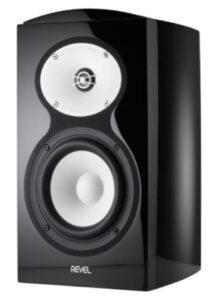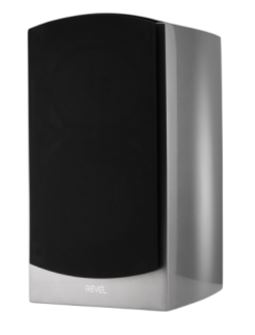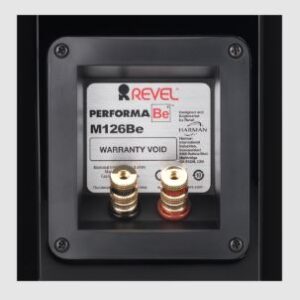The new Performa Be series of loudspeakers offers an upgrade from the well-received Performa3 series from Revel. The Be speakers feature the Revel’s latest beryllium tweeter that was first introduced more than a decade ago in the Ultima2 series. Revel is a member of the Harman International family of brands which includes Mark Levinson, JBL, Arcam, and Infinity.

The Performa M126Be is a ported 2-way stand mount, AKA bookshelf speaker weighing a back-friendly 22 pounds, not including a stand. The bass and midrange, up to the crossover point of 1.7 kHz, are handled by a 6.5-inch driver, with a DCC (Deep Ceramic Composite) aluminum cone with cast frame. The tweeter is a 1″ beryllium dome with acoustic lens waveguide. The speakers are sold singly for $2000 each, and the optional Revel M stands fetch $500 per pair. The speakers are offered in four colors: black, white, walnut, and metallic silver. Fit and finish are excellent, as we have come to expect from Revel. The enclosure is art, has curved sides and top, and exhibits very little vibration when the music gets loud.
Other components on hand during the audition include a VPI Aries 3 turntable with a Kuzma 4-Point tonearm; ZYX UNIverse Premium and Miyajima Madake moving coil cartridges; B.M.C. MCCI ULN and Pass XP-25 phono preamplifiers; custom Windows 10 music computer running JRiver Media Center; Wyred 4 Sound DAC 2v2SE 10th Anniversary DA converter; RME ADI-2 Pro AD/DA converter with exterbat_43snal power supply; Pass Labs XP-22, BAT VK-43SE, and Wyred 4 Sound STP-SE Stage 2 preamplifiers; Valvet E2, Primaluna Prologue 5 and Prologue Premium, Ayre VX-5 Twenty, Pass Labs XA30.8, and Conrad-Johnson Classic 62SE power amplifiers; Focal Sopra 1 loudspeakers with the lowest few Hertz supplied by a pair of JL Audio e110 subwoofers, Monitor Audio PL100 II, and Focal Chorus 714 loudspeakers borrowed from the HT system. The audio cabling is Audioquest WEL Signature and Mogami interconnects and speaker cables. USB cables are Straight Wire USB-F. Power cords include my DIY power cord and Straight Wire Pro Thunder. Power protection and purification are provided by a PS Audio Dectet for the preamplifiers and source components, and a PS Audio Quintet for the power amplifiers. The Quintet includes a standard 1/8″ trigger for remote turn-on and -off of power amplifiers that lack a 12V remote trigger.
The speakers were allowed 200 hours of play time to break in. After that necessary chore was ‘in the rear-view mirror’, the first sonic attribute of the M126Be that was noticed was the unusually large and precise soundstage. Dozens more hours of note-taking, critical listening confirmed the initial impression: the Revel speakers seemed to present the largest soundstage to ever “materialize” in this listening room from any speaker. These include large Magnepans, boxless Emerald Physics, and all manner of box speakers in memory and in my reviews. The virtual performance stage is impressive in all three dimensions: width, depth and height. The imaging and sound staging ability of this little speaker was judged to represent the state for the art for this characteristic. A word to describe the vast soundstage is “supernova”. The performance space can reach out to the listening position, enveloping the listener. There is no escape! The optimum center image was realized with the speakers pointed directly at the listening position. As the speakers were rotated outwards, towards 90 degrees, straight-out from the wall, the soundstage width grew, with a proportionately widened center image. A perfect Silly Putty image.
The bass is dynamic with excellent leading-edge definition. The bass can pressurize the room and shake the furniture due to the speaker’s ability to play loud. The bass is quicker and more detailed than from the Focal Sopra 1, where the Focals go deeper in the lower bass. Measuring the bass in my imperfect listening room, the Revel’s are -3 dB at 54 Hz and the Focals manage -3 dB at 45 Hz. There is an occasional feeling of low bass, but the ported alignment falls off rapidly below these numbers and a subwoofer or two is probably going to be needed for more full range sound, down in the 30 Hz area. The Monitor Audio PL100 II reaches lower into the power bass region, 30-40 Hz, and can get by without subwoofer augmentation.

The 8 Ohm M126Be has a rated SPL (Sound Pressure Level) sensitivity of 86 dB @ 1 meter. With my long-term reference Valvet E2 single-ended 12 Watt amplifier at max undistorted output, the speakers delivered nominal 80 dB SPL at the listening seat, with occasional 100 dB peaks, in my 12 x 17 ft. room. Connecting the Pass XA30.8 increases the maximum sustained loudness to over 90 dB SPL, with peaks approximately 15-20 dB louder, which is louder than I want to listen to for long. Sure, “cranking the tunes” is fun, but as I have noted in previous reviews, repeated listening at over 85 dB SPL can result in permanent hearing damage. These days, the free NIOSH – National Institute of Occupational Safety and Health – SPL meter app is often used to monitor loudness. The app is only for iOS at this time.
The forest sounds at the beginning and end of “Par Avion” by Mike & The Mechanics, Atlantic LP A1-81287, puts the listener in a spookily present environment courtesy of a richly defined and dense sound field. The excellent 3D soundstaging precision produces a natural outdoor acoustic.
On “Witches’ Brew”, from Danse Macabre, Saint-Saëns, RCA Living Stereo LP, RCA Victor LSC-2225, the bells and violins, larger strings and horns, are all very well served by the speakers’ delivery of the smallest details in the music. And again, the sound stage is wide and deep, with the violin section clearly in rows front-to-back. The overall resolution of these speakers is outstanding.
The Revels are very quick to respond to any type of signal with electrostatic-like speed and resolution. Whatever genre you like, country, rock, choral, large orchestra or small ensemble, or electronica, the M126Be delivers everything with remarkable transparency and lack of overhang. They keep all music organized and discernable.

Surface noise from LPs is more apparent than is heard from the Focal Sopra 1s, which also have beryllium tweeters. The Revel’s tweeter can be a bit bright and ruthlessly crisp, accentuating sibilants. This character is not actually created by the speakers, but there is a tendency to present the poorer recordings with some highlighting of the mid-treble, spotlighting recording deficiencies. This appears in the upper midrange as a coolness, a small lack of rich harmonic depth. With other speakers, this can often be helped by careful adjustment of the speaker toe-in, which changes the frequency response off-axis. With the M126Be, the expansive horizontal and vertical dispersion makes ameliorating this brightness a test. The sweet spot is very wide, and even standing up changes the octave-to-octave balance very little.
Listeners should refrain from making snap judgements about this speaker and listen at length in their systems. In three very different systems, listeners reported the same character that this listener observed: distracting anomalies around the crossover frequency of 1.7 kHz. Sounds around this frequency were confused, discontinuous, distorted. Some of this was attributed to the crossover itself. Changing amplifiers had only a minor effect on this unfortunate character. This points to extreme system sensitivity for good performance. I would love to revisit this promising design for a follow-up review after an update. If you do not hear any problems in this area, then you can enjoy what is otherwise an excellent loudspeaker with strengths that are found in some of the best speakers available today.
Overall Rating: 6 LPs
Link to manufacturer: Revel
